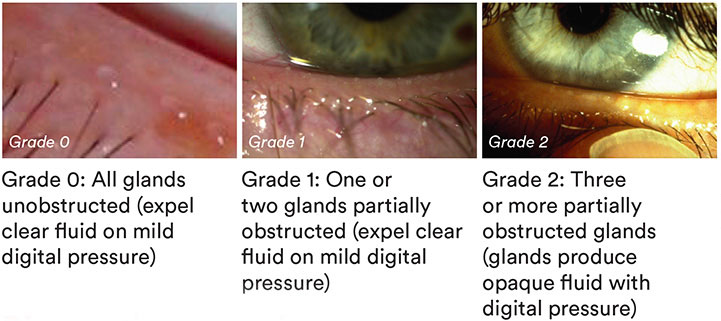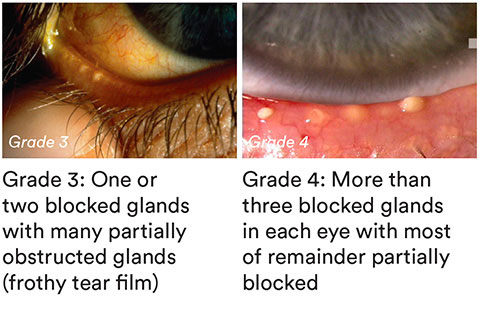What you need to know
Slit Lamp Viewing:
• Diffuse beam • Medium magnification (16x) • Direct illumination


Diagnostic expression
- Count the number of visibly capped glands
- Grade meibum quality.
Use finger, Q-tip or Meibomian Gland Evaluator (MGE) to assess 5 glands in each of 3 areas: nasal, central and temporal. Look for number of glands releasing meibum and grade meibum quality (0-45 score). Maximum score is 45 across 15 glands.
NOTE: this is a reverse scale where the highest ‘grade’ is given to the best appearance:
- Grade 3 Liquid, clear
- Grade 2 Liquid milky
- Grade 1 Thick (toothpaste/ inspissated)
- Grade 0 No secretions
Incidence:
- 4 – 20% (Caucasian population) to over 60% (Asian population);
- Increases with age, blepharitis and rosacea
Aetiology:
- Chronic, diffuse abnormality of meibomian glands (MG), with duct obstruction and/ or qualitative/quantitative changes in glandular secretion.
- Progressive inflammatory process associated with blepharitis, mechanical trauma, lowering temperature of eyelids, microbial contamination, CL wear and make-up.
Symptoms:
- Ocular discomfort
- Dryness
- Irritation & itching
- CL intolerance
- Smeary vision (greasy lenses)
- Photophobia
Signs:
- Absent or cloudy meibomian gland secretions on gland expression
- Frothy tears with reduced tear film quality and break up time
- Thickened lid margins with distorted, possibly capped, meibomian glands
- Marginal dry eye signs (inferior corneal staining, recurrent corneal erosions) clinically apparent inflammation and ocular surface disease
- Discrete lipid deposits or greasy lipid layer over lens surface

What you need to recommend to your patients
Management
- Explain chronic nature of condition to patient
- Manage ≥ grade 2 or if symptoms
- Lens wear can be continued if tolerated
- Daily eyelid hygiene including warming with proprietary masks followed by moderate to firm massage and expression of MG secretions
- In office microblepharon exfoliation
- Device assisted thermal pulsation and expression in office
- Consider CLs with shorter replacement frequency
- Artificial tears
- Advice on diet (increase omega-3 fatty acid intake), effect of work/ home environments on tear evaporation and possible drying effect of certain systemic medications
- If severe, systemic tetracyclines may be necessary
Prognosis
Generally good resolution of symptoms and improvement in tear quality following treatment.
Differential Diagnosis:

Further reading
- Arita R et al. Meibomian Gland Dysfunction and Contact Lens Discomfort. Eye Contact Lens 2017 Jan; 43(1): 17-22
- Blackie C et al. The sustained effect (12 months) of a single-dose vectored thermal pulsation procedure for meibomian gland dysfunction and evaporative dry eye. Clin Ophthalmol 2016; 10: 1385-1396
- Geerling G et al. Emerging strategies for the diagnosis and treatment of meibomian gland dysfunction: Proceedings of the OCEAN group meeting. Ocul Surf 2017; 15: 179-192
- Lam P et al. A Review on Evidence-Based Treatments for Meibomian Gland Dysfunction. Eye Contact Lens 2020; 46: 3-16.
- Schaumberg D et al. (2011) The international workshop on meibomian gland dysfunction: report of the subcommittee on the epidemiology of, and associated risk factors for, MGD. Invest Ophthalmol Vis Sci 2011; 52(4): 1994-2005
- Siddireddy J et al. The eyelids and tear film in contact lens discomfort. Cont Lens Ant Eye 2018; 41(2) 144-153
- Siddireddy J et al. Predictive Potential of Eyelids and Tear Film in Determining Symptoms in Contact Lens Wearers. Optom Vis Sci 2018; Nov 95(11): 1035-1045
- Siddireddy J et al. The Effect of Microblepharon Exfoliation on Clinical Correlates of Contact Lens Discomfort. Optom Vis Sci 2019; 96(3): 187-199
- Siddireddy J et al. Effect of Eyelid Treatments on Bacterial Load and Lipase Activity in Relation to Contact Lens Discomfort. Eye Contact Lens 2020; 46(4): 245-253
- Tichenor A et al. Effect of the Bruder moist heat eye compress on contact lens discomfort in contact lens wearers: an open-label randomized clinical trial. Cont Lens Ant Eye 2019; 42: 625-32

